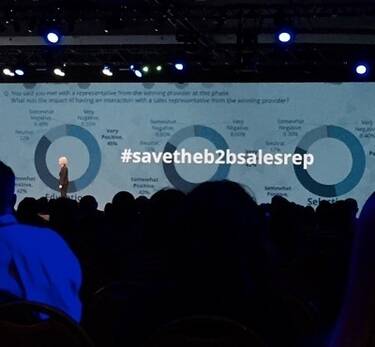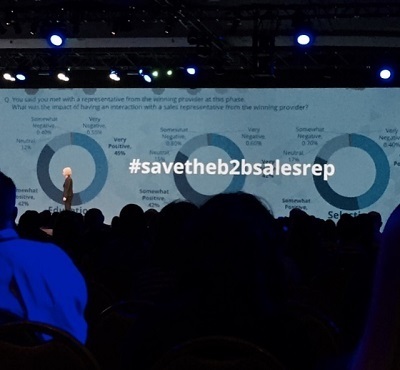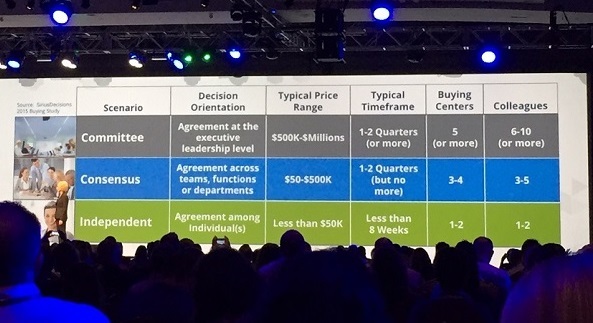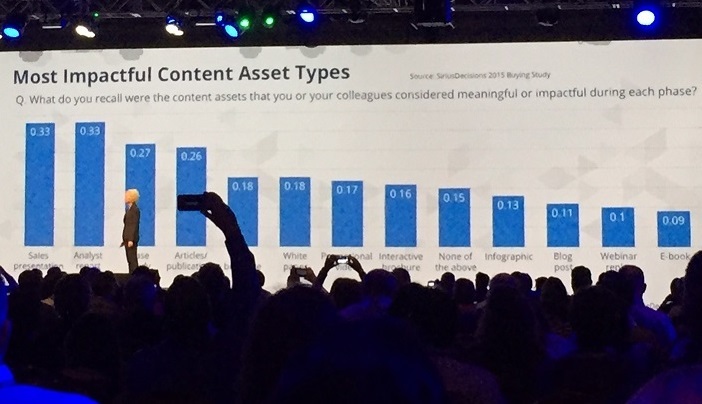#SavetheB2BSalesRep

Seeing #Savetheb2bsalesrep plastered across a giant screen at the 2015 SiriusDecisions Summit came as a complete surprise.

Few could have expected such an abrupt reversal.
Consider four years ago at the same summit, SiriusDecisions told everyone that “67% of the buyer’s journey is now done digitally.” We were witnessing the “disintermediation of sales by digital,” according to SiriusDecisions. Other sources like Corporate Executive Board added, “57% of the buyer’s journey is complete before a customer’s first contact with a supplier.” And Forrester piled on with “Death of the b-to-b salesperson.”
It was open season on the b2b sales rep.
And then that all changed during a keynote presentation at the 2015 SiriusDecisions Summit. Marisa Kopec, VP and Group Director and Jennifer Ross, Senior Research Director, CMO Strategies at SiriusDecisions revealed the findings from their 2015 B-to-B Buyer Study, which profiled 1,005 respondents, 86% of whom had purchased a product or service within the past 3 months. Among the key findings:
- B-to-b buyers interact with sales representatives at every stage of the buyer's journey.
- Sales Presentations (alongside analyst reports) were ranked as the MOST IMPACTFUL INTERACTIONS for helping buyers make a decision.
And just like that, the b2b salesperson rose from the dead.
But let’s first back up a bit to understand how we arrived at this point, because in the words of Kopec, the b2b buying journey is “not linear.” Nor is it one size fits all.
The B2B Buyer's Journey
According to SiriusDecisions the b2b buying process breaks down into three phases:
- The Education phase is where the decision is made that there is a reason for change.
- The Solution phase involves a b2b buyer choosing an approach on how to change.
- In the Selectionphase the decision on a vendor is made.
3 Buying Scenarios

SiriusDecisions also presented their new B-to-B Buying Decision Process Frameworkwhich identified three distinct buying scenarios: the committee buy, the consensus buy and the independent buy.
According to Sirius, committee buying typically involves solutions priced at $500K and above, spans 1-2 business quarters (or more) and usually involves 6-10 individuals. The consensus buy usually involves solutions priced from $50K-$500k, spans 1-2 business quarters and involves 3-5 colleagues. Finally, the least complex, the independent buy comes into play with solutions priced less than $50k, span less than 8 weeks and usually involves 1-2 individuals.
B2B Interactions: Human v. Digital
With the ground work laid about the b2b buyer’s journey and purchasing scenarios, SiriusDecisions then turned their attention to their Buying Interactions Model, which breaks down the various human and non-human interactions that can occur across that journey including:
- Facilitated interactions involve info consumption through online channels. A buyer conducts these interactions on their own and an internet search or browsing a website count in the facilitated category.
- Simulated interactions also occur primarily online but allow for more interaction through simulation, think free trials and online demos.
- Influenced interactions describe person-to-person interactions with a provider or external party. Industry conferences, peer networking events and customer references fall in this category.
- Orchestrated interactions occur when a provider “directly controls the information exchange with the buyer.” Discussions with a seller and vendor sponsored webinars count as orchestrated interactions.
As you’d expect, the study revealed that the average number of human and non-human interactions fluctuates for each buying scenario. On average less touches occur during an independent buy than a committee buy. An independent buy averaged 11 interactions while 14 touches occur during a consensus buy. The number jumps up to 17 in a committee buying scenario.
As a key takeaway, price point was cited as one of the key drivers of buying behavior. According to SiriusDecisions, “As the price point of an offering goes up, human interactions between the buyer and the provider also increase. But even at low price points, there is evidence that human-to-human interactions occur.”
A Myth Debunked

Seeing SiriusDecisions rank “meeting with a vendor sales rep” as the most impactful or second most impactful human interaction across the b2b buyer’s journey was especially validating for a company that was founded to serve sales people.
Across the board, BAOers have felt strongly, for quite a while, that the “sales doesn’t matter” rhetoric had gotten out of control. BAO isn’t shy about of love of sales people, so we were particularly happy to see SiriusDecisions set the record straight.
Perhaps it was extra gratifying, because from our point of view, digital and human interactions have never been mutually exclusive. As marketers it’s not a choice between one or the other. It’s about choosing to use ALL the tools at our disposal to make sellers more effective and successful.
Whether it be online demos, webinars, events or appointment setting, marketers should be working closely with sales to tightly integrate human and digital, to create an experience for buyers where the sum of all those interactions is greater than each of the individual components. That integrated experience is paved with creative, measurable and buyer-centric campaigns that are built upon touch points that help buyers solve their challenges and change for the better.
And SiriusDecisions supported this point of view in recommending a balanced go-to-market strategy that mixes human and digital equally.
After debunking the “disintermediation of sales by digital” myth, Kopec laid out the path forward, “the new way to think about b-to-b buying is that human interactions still occur and matter, and that the rise of digital marketing doesn't mean those interactions go away, it just means that buyers and providers are interacting in new digital ways. Just because buying behavior is done digitally does not mean that sales representatives are no longer required to instigate or facilitate a buying process.”
In SiriusDecisions’ words, “buyers need trust, confidence and validation from people when they buy.” And we couldn’t have said it any better ourselves.
Bottom Line:
In the final two thirds of the buyer’s journey, “meeting with a sales rep” ranked as the most impactful human interaction. In the first third, meeting with a sales rep ranked second to attending a vendor hosted webinar among the top ranked human interactions.
Speak with a pipeline expert to build a program that meets your needs.